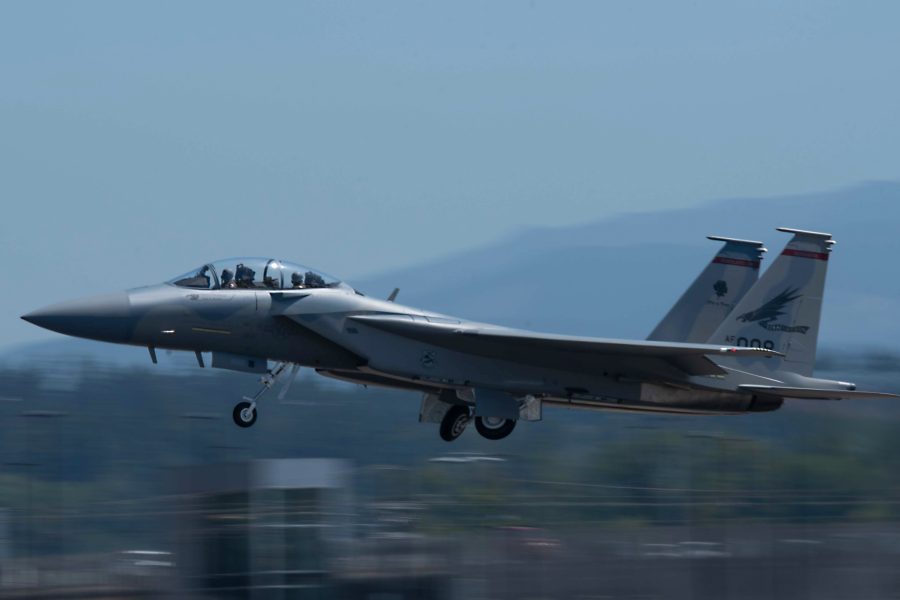The Senate Appropriations Committee greenlit an $851.7 billion budget for the Pentagon for Fiscal 2025, a 2.3 percent increase over the allocation passed by the House Appropriations Committee in June, boosting the Air Force and Space Force’s budget to deter China and Russia. Members cited “alarming moves” by Chinese and Russian warplanes, those countries’ growing space capabilities, and the need to preserve USAF airpower as proof they were making the right decision.
“It strengthens our military across all domains, in the air, on land, at sea, in space, and in cyberspace,” Collins said about the budget. “For the Air Force, the bill provides additional funding to make nearly 500 more aircraft available than the President’s budget request would allow.”
The SAC added six more F-15EX fighters than the Air Force requested and $280 million for the Next Generation Adaptive Propulsion (NGAP) engine development program.
“I want to repeat that the global security situation we see today is as dangerous as it’s ever been,” Sen. Jon Tester (D-MT) said at the committee markup on Aug 1. “Proof points, just last week, Russian Chinese bombers entered the Alaska Air Defense Zone, some 150 miles off the United States coast.”
“This is alarming,” he added.
Two Russian TU-95 Bears and two Chinese H-6 bombers encroached on Alaska’s Air Defense Identification Zone (ADIZ) on July 24. The aircraft were intercepted off the coast of Alaska by American and Canadian fighters and remained in international airspace. It was the first joint flight by China and Russia near Alaska.
“In fact, Russia and China are collaborating across the globe from space, all the way down to Russia’s unjust war in Ukraine,” added Tester.
The deepening nuclear and space collaboration between Beijing and Moscow has alarmed the U.S. military leaders. In March, the two countries unveiled plans to construct a nuclear power plant on the moon by the 2030s. China recently halted nuclear arms control talks with Washington, following Russia’s lead. The U.S. officials say China is aiding Russia’s war effort against Ukraine by supplying satellite technology and dual-use components for weapons—a claim later endorsed by NATO in July, which accused Beijing of providing military equipment to Moscow. China has, however, denied any responsibility in the conflict.
“This bill builds on the critical work we did in the national security supplemental to counter Russia’s aggression, the influence of the Chinese government in the Indo Pacific, and a lot more,” said Sen. Patty Murray (D-Wash.), the Committee’s chair.
The total funding approved by the committee also includes $1 billion more than last year’s budget request from the Biden administration to bolster counter-drone capabilities, including $350 million for 1,200 counter-drone systems and additional radars. Sen. Susan Collins (R-Maine) cited China as a primary player in that area. Vice Chief of Staff of the Air Force Gen. James C. Slife recently cited the proliferation of cheap quadcopter drones made by DJI, a Chinese company, as an issue big enough to consider how the USAF views air superiority.
The bill also includes $4.1 billion for procurement and $19.8 billion for research and development for the Space Force, adding nearly a billion dollars to address “offensive space control and other space capabilities that were excluded from the request.” Russia has made alarming advances in space weapons recently, including working on a nuclear weapon Moscow could deploy in space, U.S. officials say.
The bill adds $181 million for the Guam Defense System to tackle China’s missiles and $123 million to boost Indo-Pacific Command’s targeting capabilities. The Pentagon is ramping up efforts to boost Guam’s defense against China’s potential “complex integrated attack” scenario and deploying fifth-generation fighters to key airbases in Japan, close to Taiwan and the South China Sea.
In March, the Air Force submitted its $3.5 billion unfunded priorities list for fiscal 2025 to Congress. Instead of requesting more new aircraft, the service’s annual wishlist focused on essential needs such as spare parts, exercises, military construction, and funding for the new “re-optimization” for great power competition overhaul.
The largest single item is $1.5 billion for spare parts to prevent aircraft from being grounded due to shortages and maintenance issues. The service described this as a “spare surge”—a one-time request for spare parts with no impact on future funding plans. The Air Force noted that this request was only partially funded for FY25, with budget constraints leading to preventing full funding of all of its key programs.
“And just to emphasize how important this is, it prevents the grounding of an estimated 221 airplanes because of the lack of spare parts,” Collins highlighted.
Citing the “devastating effects” of continuing resolutions, Tester stressed the urgency of finishing the budgets on time this year.
“I want to remind everybody that last year’s budget got done six months, six months late,” said Tester. “How do we hold defense contractors accountable when we don’t do our job?”
